Rudy- the making of an icon
In the early 1980s, at a nearly sold-out UD Arena, a barnstormer crouched in one of the seating sections, trying to hide his big head among the crowd. Attached by a long rope tied to the Arena roof rafters, he leapt up and soared across the basketball court, cape flowing behind while fans laughed and pointed at the silly, but daring, mascot who brings them so much joy.
For more than 35 years, Rudy Flyer has captured the hearts of fans. The friendly, muscular mascot leads cheers at games, gives high-fives to fans and takes photos with children and alumni — all while fostering and supporting the University’s commitment to Flyer community.
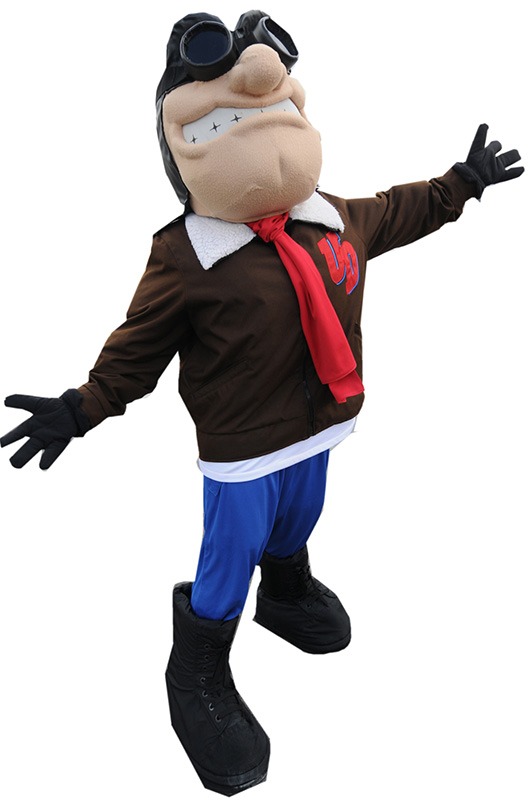 But Rudy didn’t fly out of thin air. The beloved mascot was born at a basketball game Dec. 1, 1980, after years of spirit-filled, sometimes four-legged predecessors. The history of Rudy is a story that involves those who helped conceive him, as well as the Flyer Faithful who have cheered beside and supported him along the way.
But Rudy didn’t fly out of thin air. The beloved mascot was born at a basketball game Dec. 1, 1980, after years of spirit-filled, sometimes four-legged predecessors. The history of Rudy is a story that involves those who helped conceive him, as well as the Flyer Faithful who have cheered beside and supported him along the way.
The making of this modern Flyer icon began in France in 1880 with the opera La Mascotte, composed by Edmond Audran. According to the International University Sports Federation, the popularity of the opera hastened the translation of the word and concept into English by 1881.
The term was often applied to live animals that U.S. sports teams brought to games to intimidate opponents and entertain fans. The University of Dayton had its own livestock, such as a chicken who once appeared at a soccer game. In 1956, the Flyer News interviewed Pedro the Donkey, which the writer described as having “large, dreamy, brown eyes” and a red and blue blanket with the letter “D.” “I hope to be on the Flyers’ team for many years to come,” Pedro was quoted as saying.
But Pedro’s days — and those of live animal mascots everywhere — were numbered after the popular embrace of the Muppets, those plush, sarcastic creations of puppeteer Jim Henson.
According to the federation, teams in the late 1960s started creating Muppet-like mascots that were friendly with fans and good at helping teams with marketing and public relations efforts.
Up until the early 1970s, the University of Dayton didn’t have an official mascot. In 1972, Gene Schill, the director of athletic public relations and promotions, sent a letter to world-renowned cartoonist Milton Caniff.
In his letter, Schill wrote, “To the best of our knowledge, UD is the only college or university in the country with the nickname of ‘Flyers,’ and it has been a source of irritation to the Department of Athletics that we have not had an official mascot or logo for use on decals, tee shirts, letterheads, etc.”
Ohio born and Dayton raised, Caniff had become famous for creating the comic strips Terry and the Pirates and Steve Canyon. When asked to draw UD’s mascot, Caniff inked the D-Bird — part bird, part plane to help represent the Flyers nickname while also paying tribute to Orville and Wilbur Wright, the inventors of powered flight.
Caniff described the D-Bird to Schill in a letter, now housed at the Billy Ireland Cartoon Library & Museum at Ohio State University.
“The drawing shows a winged-goggled-beaked-helmeted creature, carrying on its head a flashing, beacon-like device and brandishing four menacing legs each wearing a different kind of shoe (football, basketball, track and baseball),” Caniff wrote. “The blue helmet bears the U. of D. major letter in red. The bird’s bill and legs are also in the school’s traditional red color.
“The wings represent the Wright Flyer aircraft which gave the teams their nickname of Flyers. The shoes symbolize the major sports in which the University participates while the aggressive attitude of the bird diving out of the sun on its prey reflects the competitive spirit of the various athletic teams.
“Topping it all is the flashing light reminding the viewer that learning is the main issue of any university function. The participants in sports are there for an education. As an antenna, the symbol indicates that these athletes are in touch … they are with it!”
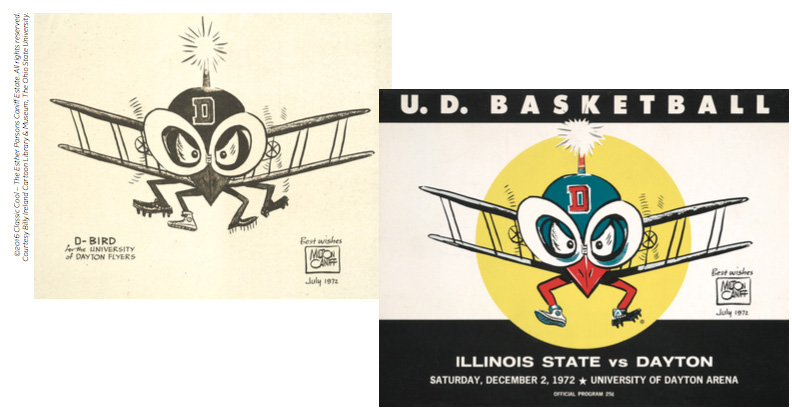
Dayton Daily News sports writer Hal McCoy called it “a weird little creature” when it debuted on a football program in fall 1972. But the D-Bird had huge wings attached to his back and two stubby legs, giving it a form with no hope of translating into a human-inhabited costume.
By the late 1970s, UD was ready to try again, and this time it wanted a walking, cheering mascot.
First, UD identified the person who would inhabit the costume. Ric Cengeri ’81 was an enthusiastic management major with a passion for basketball. He was discovered at the 1979-80 AIAW Women’s Basketball National Championship, hosted at the Arena. While waiting for the Flyers to take the court, Cengeri cheered on William Penn, later helping rally the William Penn fans to push their team to win in the overtime consolation game.
UD’s band director and cheerleading adviser took note and invited Cengeri to try out for the cheerleading squad.
“I was terrible,” Cengeri recalled. “I had all kinds of spirit, but I couldn’t do the lifts.”
The team kept Cengeri from potentially dropping fellow cheerleaders by having him entertain fans with mannequins and other skits.
Around this time, the band director approached Athletic Director Tom Frericks ’53 about getting a mascot costume, said Rory Falato ’77.
“Tom Frericks was intent on building up the basketball program,” said Falato, director of athletic and arena promotions at the time. “He understood the benefits not just for the athletic department but the University as a whole.”
Frericks knew a competitive basketball team would attract students, and Rudy became part of refining the Flyer sports brand. “We started selling Flyer merchandise at games,” Falato said. “There were blue crying towels and kids’ dribble-pass-and-shoot contests at halftime. Get people involved. Fill the seats. Make it family friendly. It’s not just a game, it’s an event.”
The athletic department hired southwest Ohio artist D.W. Biggs to draw the first Rudy, who resembled a 1920s barnstormer, a term used to describe stunt pilots performing tricks with their planes. UD sent the watercolor and ink image to Stagecraft, a Cincinnati mascot design company, where owner Randy Kent brought the drawing to life.
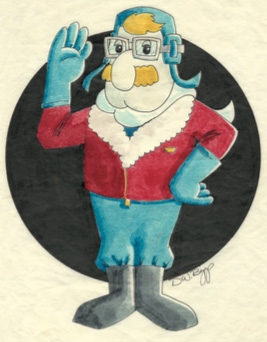 Kent said he started by first sculpting the head, then adding a giant mustache below the bulging nose and topping it with a leather pilot cap. Next came the body, arms and feet, all covered with a flight jacket, pants, gloves and high-top boots.
Kent said he started by first sculpting the head, then adding a giant mustache below the bulging nose and topping it with a leather pilot cap. Next came the body, arms and feet, all covered with a flight jacket, pants, gloves and high-top boots.
Just after the costume arrived on campus, it suffered a wardrobe malfunction. The mascot’s goggles came loose and needed to be reattached. So the costume was sent back to Stagecraft, and Kent said he glued the goggles back on and brought it up to Dayton so that it could be used for the game that night, Dec. 1, 1980, against San Francisco.
Cengeri said he put the mascot head on, immediately smelled the glue fumes and became lightheaded. But he performed his role as the mascot for the night.
The following day, the head was placed in the ticket office. Cengeri said that the fumes from the glue were so bad the ticketing employees evacuated the office.
The fumes did not discourage Cengeri, and at the Jan. 24, 1981, basketball game against Marquette, the mascot finally got his name. The athletic department had run a promotion, with fans ranging in age from 4 years to Golden Flyers submitting entries of their favorite names. It was Falato’s idea.
“I had the bright idea to have a name-the-mascot contest with a group of randomly chosen fans who would vote on the name,” he said. He received more than 600 entries, including Pontius Pilot and Freddie Flyer. “It came down to Barney Barnstormer and Rudy. The name Rudy reminded me more of a WWI German Flying Ace. But, that’s what they picked,” Falato said.
Falato took to the Arena floor and made the announcement — and it sounded as if all the fans in the Arena were booing, he said.
“We stuck with it,” Falato said. “Here we are almost 40 years later, and he’s still around. I’m very proud of that, but I will tell you I’ve never had a name contest again.”
Cengeri said it took fans several years to embrace the name, but they warmed to the mascot quickly, making the man in the costume proud.
“It was the best,” said Cengeri, now a producer and announcer with Vermont Public Radio. “I’m a massive sports fan. I love the UD Flyers. To be able to attend every home game and some away games — to be right there on the floor — it was fantastic.”
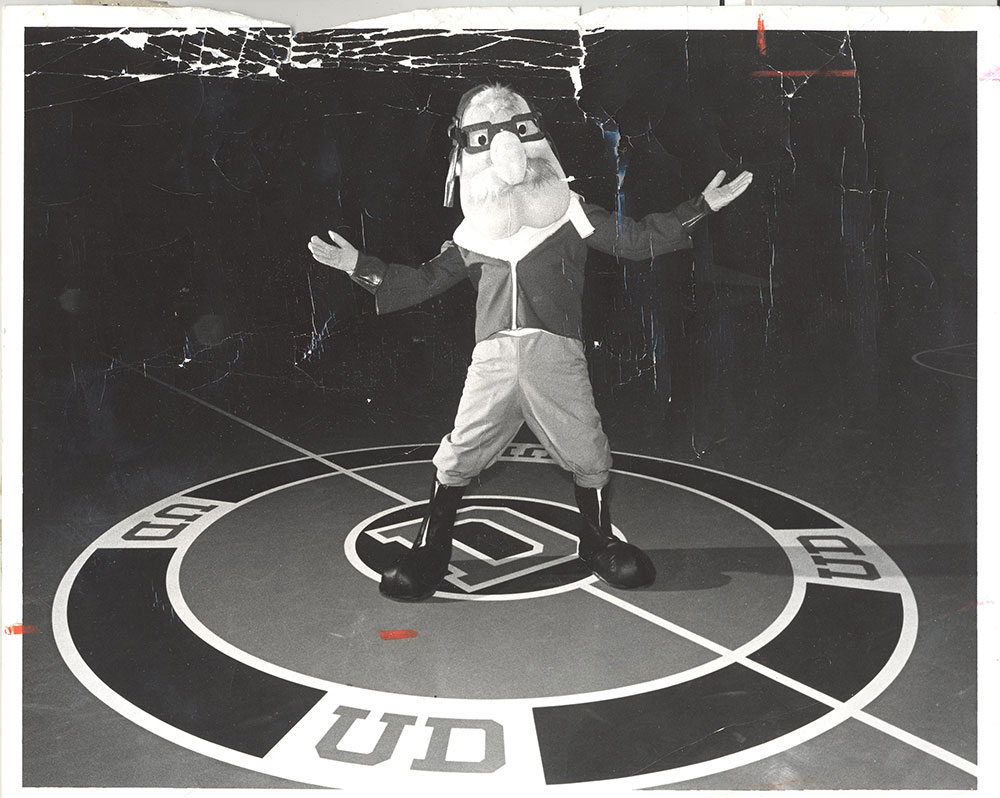
While Rudy rallied support for the Flyers, the fans began supporting their mascot and transforming him into a cherished icon, said Joe Yokajty ’85, who became the mascot in 1982.
“During my second year as the mascot, Rudy started getting fan mail from some of the kids attending the UD games,” Yokajty said. “It was awesome.”
Yokajty made sure to reward the fans with some antics he knew they’d love, including the night when he got to fly.
Yokajty said he was hidden in one of the seating sections, then jumped out and flew across the basketball court with the cape on his back.
“I am still amazed that President Brother Raymond Fitz gave the ROTC permission to tie me to a long rope attached to the ceiling rafters. I think it was because we were both engineers,” said Yokajty, now an engineer based in Rochester, New York.
As Rudy got older, he not only got more adventurous but also more hip.
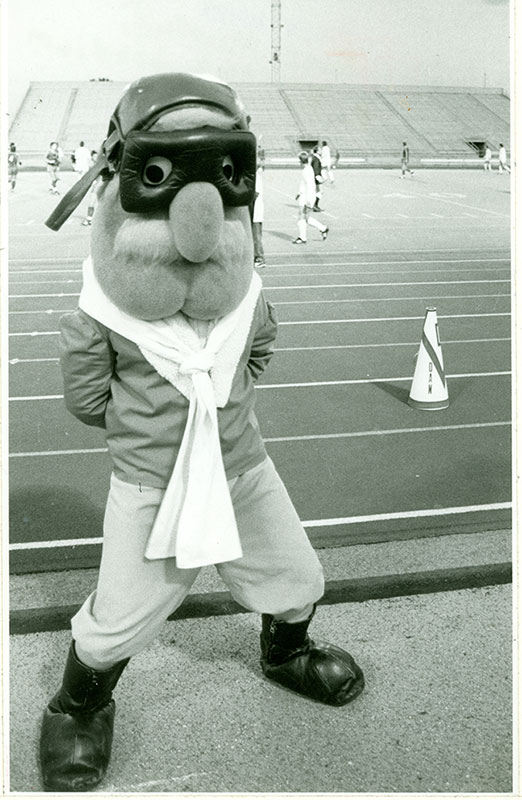 “Back in 1983, Michael Jackson first performed his Moonwalk on a TV program celebrating the history of Motown,” Yokajty said. “Rudy immediately taught himself the legendary move and incorporated it into his own dance routine during a Flyer basketball halftime. I swear most of the women in the Arena screamed.
“Back in 1983, Michael Jackson first performed his Moonwalk on a TV program celebrating the history of Motown,” Yokajty said. “Rudy immediately taught himself the legendary move and incorporated it into his own dance routine during a Flyer basketball halftime. I swear most of the women in the Arena screamed.
“Rudy’s head might have been even bigger that day.”
The head was big, yes. And hot, with Yokajty losing up to 10 pounds while working football games. And, well, funny-looking.
“At one point Rudy’s face became a bit worn,” Yokajty said. “I overheard folks saying Rudy looked a bit like Mr. Potato Head. That was somewhat embarrassing for Rudy, until the costume was sent away for restoration that summer.”
Fans continued to think that Rudy looked like Mr. Potato Head throughout the 1990s. In 1997, the University decided Rudy needed to grow up.
According to a Dayton Daily News article by Bucky Albers, Rudy received a new blue pilot suit, red satin scarf, black boots, a black leather cap and goggles.
“The floppy-footed World War I biplane pilot who has frolicked at UD Arena for the past 17 years has been replaced by a character who looks more like Chuck Yeager,” Albers wrote in the article, referring to the famed test pilot who in 1947 became the first person to break the sound barrier.
More changes took place in the mid-2000s, Jay Nigro ’06 explained. After he became Rudy in August 2004, the mascot upgraded his blue jumpsuit by adding muscles and a bomber jacket. Rudy started wearing the basketball team’s jerseys and even the same shirt as Red Scare when rival Xavier came to town.
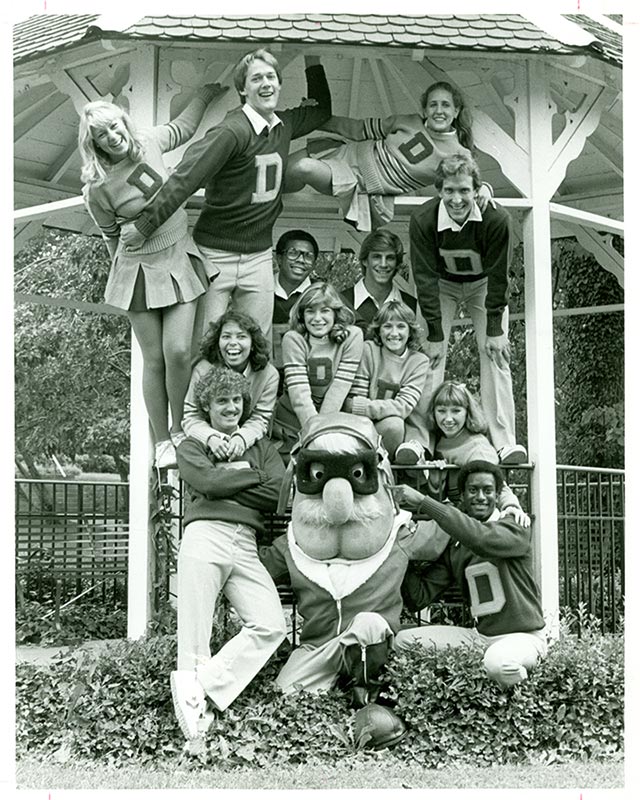 “They pretty much let me go where I wanted to go,” said Nigro, who now owns Liftoff Entertainment in Dayton. “It was a lot of fun interacting with fans,” he added, noting that he would walk to where his professors were sitting. They had no idea who was in the costume.
“They pretty much let me go where I wanted to go,” said Nigro, who now owns Liftoff Entertainment in Dayton. “It was a lot of fun interacting with fans,” he added, noting that he would walk to where his professors were sitting. They had no idea who was in the costume.
“It was something I’ll definitely remember about my college experience. Everyone loves Rudy,” he said.
Four years ago, Rudy beefed up his image again — taller, bigger and more muscular, said Adrienne Green ’08, director of marketing at UD Arena. He donned a new muscle suit and got a new bomber jacket, though he does dress for the occasion.
“We get all kinds of requests, even on campus,” Green said about Rudy’s appearances at weddings, alumni events, Christmas and birthday parties, and fundraisers.
Rudy Flyer donned a red satin scarf for a special occasion in 2011. “Guests were entertained by Rudy Flyer, who made a surprise appearance during the reception,” wrote Paula Veihdeffer Markley ’07 for her wedding announcement in UD Magazine.
Becky Dunn Kaster ’07 and Chris Kastner ’07 couldn’t have Rudy at their wedding, so they had the next best thing — a custom cake topper with boy and girl Rudy standing beside a Lowes Street sign.
“Rudy to us means family,” said Becky Kastner, “whether it’s our family members who also went to Dayton, our close-knit friends from UD who are now like family or the alumni community as a whole. Even though we graduated almost 10 years ago, the Flyer spirit remains with us and is something that we are both proud of.”
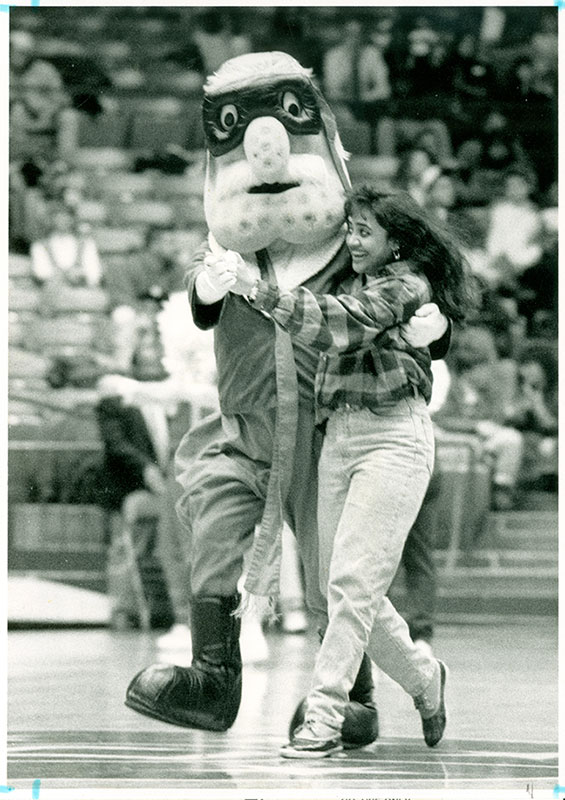 For some, Rudy even becomes part of the family. Collin Brown ’11 and Alison Roell Brown ’11 named their dog Rudy.
For some, Rudy even becomes part of the family. Collin Brown ’11 and Alison Roell Brown ’11 named their dog Rudy.
“We are both big UD sports fans and like to see Rudy motivating the crowd,” said Collin Brown.
Fernando del Monte ’08 and Molly Bytnar del Monte ’07 also named their furry yellow pup Rudy. “The main reason we named our dog Rudy was to remind ourselves of where we met,” Fernando del Monte said. “Our time at UD was so incredible.”
When the Arena marketing crew discusses how to schedule Rudy, they capitalize on his fan appeal to make a good time even better — including delivering free food during game breaks. “People like to get a pizza, especially if it’s from Rudy,” Green said.
Two to four students per school year have the opportunity to be Rudy, and their ideal height is between 5-foot-7 and 6-foot-3. If someone is not in that height range, the suit becomes disproportional, and Rudy loses his powerful image, Green said.
“I have a lot of respect for our students who do Rudy,” Green said. “It’s hot in there, and you can’t see anything. But it’s fun, and people get excited to see you.”
The love for Rudy — and Rudy’s evolution — continues. This year, Rudy will be able to be in two places at the same time; the athletic department had the costume “cloned.”
Such adaptation calls for a formal portrait. As of fall 2016, fans can purchase Rudy’s likeness on T-shirts, key chains and cut-outs.
Although Rudy has undergone many changes throughout the years, one thing remains the same: his readiness to cheer on his beloved Flyers with an army of Flyer Faithful beside him.
Michelle Tedford ’94 contributed reporting to this story.